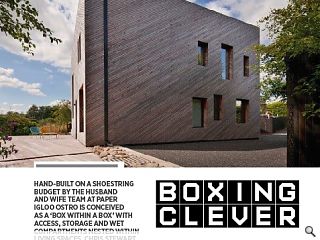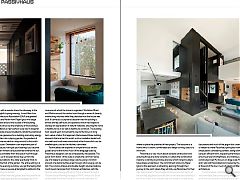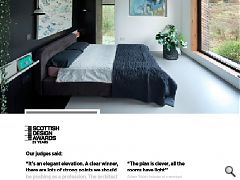Ostro Passivhaus:Boxing Clever
12 Jul 2022
Hand-built on a shoestring budget by the husband and wife team at Paper Igloo Ostro is conceived as a ‘box within a box’ with access, storage and wet compartments nested within living spaces. Chris Stewart, director at Collective Architecture, sees first hand how beauty and durability need not be compromised in pursuit of energy efficiency. Photography by David Barbour.
Passivhaus can look like anything and be built from anything, the materials and structure you choose are your own. Not my words, but those of Paper Igloo Architecture, at the Edinburgh Architectural Association’s virtual building visit to their recently completed home. The house is very beautiful but even more alluring is to listen to Paper Igloo describe their approach to architecture, discarding the myth that Passivhaus requires you to live in a plastic bag with no openable windows. A Passivhaus which is not passive (none completely are), requires the user to interact with the building and leads in the use of healthy natural materials. Passivhaus is the construction method they used to hang their design decisions.
The tour starts with a wander down the driveway to the front door on a delightful spring evening. Jo and Alex from the Edinburgh Architectural Association (EAA) are greeted by a relaxed Mhairi and Martin from Paper Igloo who begin by guiding the camera around the outside of the building. Immediately you are struck by the simplicity of the building’s form and use of material, a near-perfect cube clad in diagonal Siberian Larch. Facades are punctuated by randomly positioned windows perhaps too generous for a building promoting energy efficiency. It all nestles into a sloping garden, the gradient of which allows the entrance deck to wrap around to the south-facing side of the house. Orientation is an important part of Passivhaus and once you have got your bearings you become aware that the larger windows are positioned towards the sun. The garden is fed by rainwater from the sedum roof through a soak-away made up of recycled stone dug up from the excavation of the foundations; the water eventually finds its way to the burn at the foot of the garden. The entire setting is a pleasure and with the evening sunshine, you get the feeling that our tour might end here, as we are all tempted to settle into the garden furniture and go no further.
Wrenching ourselves from the garden and the sunshine we are led through the front door and are immediately struck by a second complimentary cubic form, a stained timber central core around which the home is organized. We follow Mhairi and Martin around this central core through a series of cleverly interlocking volumes while they describe how the house was built. It comes as a surprise to discover that the building is almost entirely self-built, an experience which has helped to develop an appreciation of natural materials, ensuring the home is healthy to live in as well as healthy to construct. The building took several years to build partly due to the focus on long term value; a fabric first approach that ensured those building elements that are hard to revisit, such as insulation levels built into walls and roofs were maximised while those which can be dwelled upon, such as the kitchen, come later.
Technicalities are explained in simple terms as we are guided around the home. Much of the language used by Passivhaus designers can be unnecessarily inaccessible. The good ‘form factor’ of the cube is simply the common-sense use of a shape to enclose a large volume using a minimal amount of external surface area through which energy can be lost. The window shapes and double-height volumes balance much loved memories from Victorian architecture with the need to ensure energy efficiency. This is achieved through a ‘Passive House Planning Package or PhPP’; which is an Excel spreadsheet that brings together the various elements of the building and allows the designer and end-user to choose where to place the priorities of their project. The outcome is a home which is warm, comfortable and keeps running costs to a minimum.
Passivhaus is very much about sensible construction and ensuring things are done correctly. A culture the construction industry is starting to embrace and one which honest builders have always understood. The commitment shown by Paper Igloo to this approach is refreshing, learning through their journey to the point where they will only use Passivhaus for their new build projects. They struggle to think anymore in terms of the building regulations and the low bar we have set ourselves, a bar which many in our industry see as a target to scrape below.
I am a Passivhaus designer and familiar with many of these discussions and much of the jargon but understand more effort is needed to make Passivhaus principles more accessible. It is simply about considering context, being careful with orientation, using an efficient form, respecting thermal performance, ensuring a level of airtightness, and making sure the building is constructed well. My focus is on large scale Passivhaus housing and I was both fascinated and inspired by the conversation at the end of the tour, much of which will filter into my field of architecture.
I must however conclude with a confession, my internet let me down badly that sunny spring evening and I was only able to enjoy the tour through a recording on a grey weekend morning, it was though a whole lot brighter at the end.
|
|





